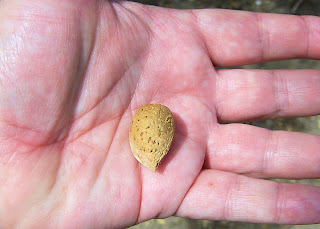It's official, we're right in the middle of Harvest Season.
(photos by Janice Seagraves)
The tree shaking has already happened and all the yummy goodness of almonds are laying on the dirt, waiting until they're dry enough for the sweeper to sweep up. This is all done by a machine driven by one man. It blows the nuts over until he has them lined up into one long neat row. Later he'll show up again to sweep up the almonds, which will then be loaded up into the back of a semi truck trailer to be taken off to the processing plant.At the plant, they'll be taken out of their shell and the almonds cleaned and then roasted before they'll dust with salt or seasonings and boxed up for sale.
Across the street the raisin harvest is underway. Again what used to take a work crew of ten to twenty takes only three men to pull off. Long lengths of paper are laid out down the rows of grapes, then the huge picker pulls off the grape bunches off and lays them down in a flat even row. Later workers will come to cut off length of the paper and turn them over onto fresh paper so the grapes can dry on the other side. After drying they'll be gathered up and dumped into either gondolas or the semi truck trailers and taken away to a processing plant where the rains will be cleaned, destemmed, dried again before being boxed up for shipment.
My husband works at a local winery. It's the biggest plant in my home town and hubby works there as graveyard foreman. He's a industrial maintenance mechanic and keeps the plant running.
The crush season is underway: The grapes are harvest like the raisin grapes but instead of being laid out to dry are then loaded up into gondolas or the trailers of semi-trucks, then they are brought to where my husband works. Weighed, the sugar content checked before being off loaded into the crush area, where they are turned into juice and the steams, seeds and grape skins are removed. Wine grapes almost always have seeds. The juice is put into great big silos some six stories tall, where later a yeast culture is added. Yeast eats the sugar in the grape juice producing alcohol, which in turn changes grape juice into wine.
A lot has changed in the last twenty years in how produce reaches the market, and less and less people are needed. One of the reasons that the work has become so mechanized is that the workers are getting harder to come by because of the tougher migrant laws since 911.
In my home town, the farmers have gotten together and decided to share the same work crew. They rotate the work and keep the migrant workers busy all year long, so they'll stay and be available when they are needed.





4 comments:
It’s very interesting and fascinating how big a difference the climate make… In our area it’s only various sorts of grain and various sorts of apples, pears and some berries which can be grown. –And hardly in such an amount that it can be exported…
It’s funny to hear about where everything comes from – not only from a shelf in the local supermarket!!:-)
Hi Sono,
I live in a dry arid area. We can only farm here with the water from irrigation. The water comes from the mountains or is pumped from deep underground.
The area where I lived is nicknamed the breadbasket of the world or California's heartland.
We grow a great many things here from nuts to fruit and grains too.
I hope you enjoyed my post.
Janice~
I love almonds. I eat a lot of them, raw...they're a part of my daily diet...almonds along with raw walnuts, macadamias, pecan, Brazils and hazelnuts. Yum! Yum!
Hi Lee,
Nuts, especially almonds, are very healthy for you.
As long as you don't over do. ;)
Janice~
Post a Comment